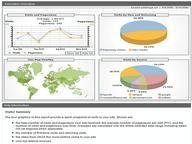Quiz Answer Key and Fun Facts
1. In statistics, the mean is the sum of all the observations divided by the number of observations. In other words, the mean is the average value of a set of data. The mean of a set that consists of five data points is 20. You are also given that three of the five data points are 5, 15 and 30. The remaining two numbers share the same value, which is ___.
2. There are many types of mean. The most common ones are arithmetic mean and geometric mean. Arithmetic means are calculated by first summing up all the individual data points, then dividing the summation by the number of observations. On the other hand, to find the geometric mean of a set of data, which two mathematical operations are involved?
3. In mathematics, there is a statistical measure of the magnitude of a quantity which can take both positive and negative values. This measure is very useful for data points which are obtained from trigonometric functions. Its abbreviation is RMS. What does it stand for?
4. In statistics, the mode refers to the value which occurs with the highest frequency in a set of data. For example, 2 is the mode for the set of data points 1, 1, 2, 2, 2, 2, 2, 3, since 2 occurs most frequently. Now, if we have a set of data which consists of 1, 1, 1, 2, 2, 2, 3, what is (are) the mode(s)?
5. You are given a bell-shaped Gaussian distribution graph which is a continuous probability distribution. Where can you find the mode? At the ___ of the graph.
6. Unlike the arithmetic mean, the mode of a set of data is not unique (can have more than one value). What is the mode for the following data points? 1, 2, 3, 4, 5, 6, 7, 8, 9, 10.
7. In statistics, the median of a set of data is more commonly known as the "middle" data. Let say we have 10, 20, 30, 40, 50. So, its median is 30. What is the median for the following set of data, which has an even number of observations? 10, 20, 30, 40, 50, 60.
8. Before finding the median of a set of data, what is the crucial step that we need to do?
9. The alternative name(s) for the median is (are) ___.
10. What is the relationship between the mean, the mode and the median for a standard normal distribution?
Source: Author
Matthew_07
This quiz was reviewed by FunTrivia editor
crisw before going online.
Any errors found in FunTrivia content are routinely corrected through our feedback system.


